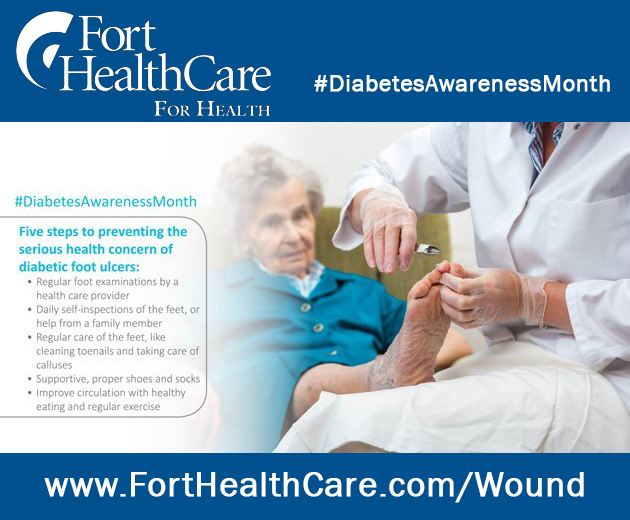November 15, 2018
Diabetes Awareness: Diabetic Foot Ulcers
 Fall can be an unwelcome time of the year if you have diabetes. Cool evening walks and hiking through those crunchy, fallen leaves aren’t as appealing when you have a foot ulcer. A diabetic foot ulcer develops because of nerve damage or injury in the feet (where the nerves are the longest in your entire body). If you lose feeling or sensation in your feet, small sores go unnoticed until a larger, more serious ulcer develops.
Fall can be an unwelcome time of the year if you have diabetes. Cool evening walks and hiking through those crunchy, fallen leaves aren’t as appealing when you have a foot ulcer. A diabetic foot ulcer develops because of nerve damage or injury in the feet (where the nerves are the longest in your entire body). If you lose feeling or sensation in your feet, small sores go unnoticed until a larger, more serious ulcer develops.
By following a few simple tips, you can prevent a wound from developing or can help one to heal.
To prevent a foot sore from progressing:
- Do a daily foot check using a mirror to see if any redness or soreness exists.
- Before wear, examine shoes for any sharp edges or tears on the inside.
- Wash your feet every day with warm water and a mild soap.
- Wear well-fitted shoes.
- Cover your feet (except between the toes) with petroleum jelly, lanolin lotion or a cold cream before putting on shoes and socks.
- Use an emery board or pumice stone to remove dead skin. Leave any calluses since they act as protective padding.
- Cut toenails straight across. Don’t leave any sharp edges that can prick other toes.
- Don’t cross your legs. It can reduce blood flow to your feet.
- Ask your doctor to check your feet at each visit.
- If your feet get cold, wear socks to bed.
- NEVER go barefoot! Barefoot activities, like swimming or walking on the beach, can be dangerous for people with diabetes. Make foot protection a top priority.
In honor of November being Diabetes Awareness Month, we want to make sure you know how to keep your feet healthy.
An estimated 30.3 million people in the United States (9.4 percent of the population) have diabetes, including 7.2 million who are unaware they are living with the disease. The percentage of adults with diabetes increases with age, reaching a high of 25.2 percent among those aged 65 years or older. In addition to age, risk factors for diabetes include diet, activity level, obesity and heredity. High blood sugar levels, poor circulation, immune systems issues, nerve damage and infection may contribute to a diabetic foot ulcer.
If you already have a foot ulcer that needs treatment, especially if it won’t heal on its own, talk to your physician and/or diabetes educator about the Wound & Edema Center. Our staff has special wound treatments available that aren’t offered in a typical doctor’s office. A physician referral is not required but is suggested. We will keep your physician up-to-speed on your progress all along the way.
Learn more at FortHealthCare.com/Wound.
